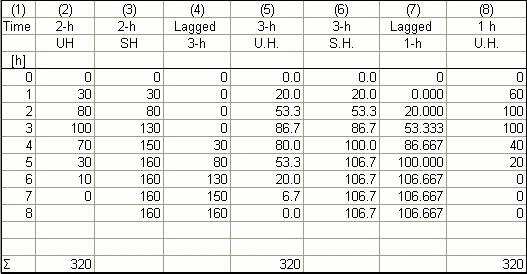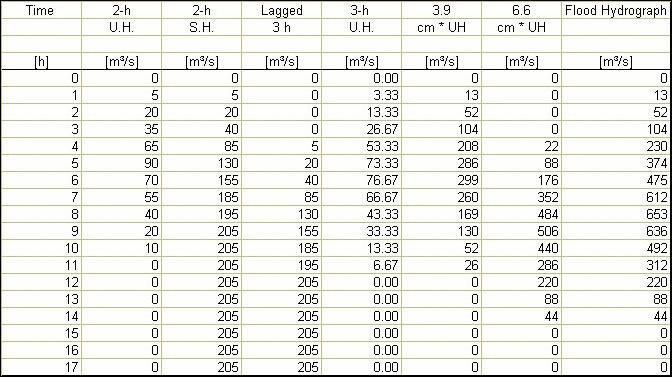SPRING 2003
SOLUTIONS TO HOMEWORK 7 , CHAPTER 5
Problem 7-1

|
The 3-h unit hydrograph is shown in Col. 5; the 1-h unit hydrograph is shown in Col. 8. The sum of Cols. 2, 5, and 8 is the same. The output from online S-hydrograph verifies hand calculations. ANSWER.
Problem 7-2
The total rainfall in the 6-h period is: P = 9 in. With runoff curve number CN = 84 and total rainfall P = 9 in., use Eq. 5-8 to calculate the direct runoff Q: Q = 7.06 in. Assume φ-index between 0 and 0.5 in./h. Therefore: [ (1.0 - φ) • 2 h + (2.0 - φ) • 2 h + (1.5 - φ) • 2 h ] = 7.06 in. Solving for φ: φ = 0.323 in/h. Rainfall intensities and depths are as follows.

|
The unit hydrograph is convoluted with the effective rainfall depth pattern as shown in the following table.

|
To verify that the composite-hydrograph ordinates are correct, the radio of sums ( 3178 / 450 = 7.06) should be equal to the sum of the effective rainfall depth: (1.354 + 3.354 + 2.354) = 7.06. The composite hydrograph for the effective storm pattern is shown in Col. 6. The output from online Convolution verifies hand calculations. ANSWER. ANSWER.
Problem 7-3
To convolute the 2-h unit hydrograph with the effective storm pattern defined at intervals of 3 h, it is necessary to change the unit hydrograph duration to 3 h. The change in unit hydrograph duration and unit hydrograph convolution are shown in the following table. The same results are obtained with online programs S-hydrograph and Convolution (see attached).

|
Problem 7-4
(1) For shallow concentrated flow, paved, use Fig. 5-18 with slope S = 0.01 to find the average velocity (along the hydraulic length) is: V = 2.05 ft/s = 0.625 m/s. Therefore, the time of concentration is: tc = L / V = 3350 / 0.625 = 5360 = 1.49 h.
(2) For 48% of the watershed area: for urban 1/3-ac lots, with lawns with 85% grass cover (i.e., in good hydrologic condition), 34% total impervious area, soil group C, use Fig 5-2(a) to find the pervious area (open space) CN: CN = 74. With pervious area CN = 74 and 34% total impervious area find the composite CN from Fig. 5-16: composite CN = 83.
(3) For 52% of the watershed area: for urban 1/3-ac lots, with lawns with 95% grass cover (i.e., in good hydrologic condition), 24% total impervious, 25% of it unconnected, soil group C, use Fig. 5-2(a) to find the pervious area (open space) CN: CN = 74. With pervious area CN = 74, 24% total impervious area, 25% of it unconnected, find the composite CN from Fig. 5-17: composite CN = 79.
(4) The runoff curve number for the entire watershed is obtained by areal weighing: CN = [(83 • 48) = ( 79 • 52)] / 100 = 80.92. Use CN = 81.
(5) With CN = 81, use Eq. 5-49 to calculate the initial abstraction Ia: Ia = 1.2 cm
With P = 12 cm, the ratio Ia / P is: Ia / P = 0.1
With P = 12 cm, CN = 81, and R = 2.54, use Eq. 5-9 to find Q: Q = 6.97 cm.
Use Fig. 5-19(a), with rainfall type IA (Pacific Northwest region), time of concentration tc = 1.49 h, and ratio Ia / P = 0.1, to find the unit peak discharge qu: qu = 95 ft3 / (s-mi2 / in)
Converting to SI units: qu = 95 ft3 / (s-mi2 / in) • 0.0046 = 0.409 m3 / (s-km2-cm).
For 0.2% pond and swamp areas, use Table 5-12 to find F: F = 0.97.
Using Eq. 5-47: Qp = 0.409 m3 / (s-km2-cm) • 8.5 km2 • 6.97 cm • 0.97 = 23.5 m3/s.
The 50-y peak discharge is: Qp = 23.5 m3/s. ANSWER.
Problem 7-5
THANK YOU FOR RUNNING EH500.
THIS PROGRAM SOLVES THE SCS TR-55 GRAPHICAL METHOD.
ARE YOU USING SI UNITS (Y/N)?: y
ENTER CATCHMENT AREA (KM2): 8.5
ENTER RAINFALL DEPTH (CM): 13
ENTER RAINFALL FREQUENCY (Y): 100
ENTER RUNOFF CURVE NUMBER: 81
ENTER STORM TYPE.
(ENTER 0 FOR TYPE IA, 1 FOR TYPE I, 2 FOR TYPE II, 3 FOR TYPE III): 1
ENTER TIME OF CONCENTRATION (H): 2.5
ENTER PERCENTAGE OF POND AND SWAMP AREAS: 1
THE 100-Y PEAK DISCHARGE IS: 30.013 CUBIC METERS PER SECOND.
THANK YOU FOR RUNNING EH500. PLEASE CALL AGAIN.
ANSWER.